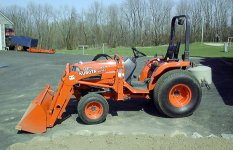Jerry,
Do you have access to Microsoft Excel?/w3tcompact/icons/smile.gif
I have an Excel file with some calculations I did to try and figure out "how much ballast is enough" and make sure my tractor was going to be stable. Someone with more experience could probably just eyeball it, but I don't have the experience and was curious about how the numbers work out.
As I see it, it's all about center of gravity - not height, but length-wise, and the resulting weight distribution on each axle under different attachment combinations. You start out with the tractor only, which has a weight and a c.g. location along it's length (this is what determines your front/rear weight distribution, like 60/40, 50/50, etc.). As you consider different attachments, like a loader, you add the approximate weight of the attachment and it's approximate c.g. Depending on the attachment's c.g. and weight, then the c.g. of the tractor plus attachment will shift. If the c.g. is shifted too far towards either the front or rear axle, that's when you start to lose stability.
What I found out was that running a 400 lb tiller as counterweight for the loader is pretty safe, unless I was really maxing out the loader capacity (breakout force). I have seen this in practice while carrying some good size rocks in my loader - the rear wheels did not lift, but the front tires left some impressions in the lawn where there would usually be none, meaning that the front end was pretty loaded up.
Well, I guess I'm done. Nothing like whipping something simple into a complex mess/w3tcompact/icons/wink.gif.


